Cross-generational Reactions to Marian art
Mary, Images and People
– Father Johann Roten, S.M.
A MARIAN ART SURVEY
How do people react to Marian images? The saying goes that there is no point in discussing taste and colors, meaning that there are as many opinions about art as there are people.We wanted to pursue this issue and conducted a survey to explore convergences and patterns, or the lack thereof.
The following report is the result of a joint venture between The Marian Library/International Marian Research Institute and the University of Dayton Department of Psychology. It was written and illustrated by Dr. D. Polzella whose enthusiasm, inquisitive mind and fine sense of art contributed greatly to bringing this project about.
METHOD
Participants
Twenty-One participants were sampled from three separate populations. The first sample, comprising 112 participants (65 females, 47 males), consisted of students from parochial high schools in Dayton, Ohio. Their ages ranged from 13 to 18 years. The second sample, comprising 71 participants (43 females, 28 males), consisted of undergraduate students from the University of Dayton. Their ages ranged from 17 to 24 years. The third sample, comprising 27 participants (14 females, 13 males), consisted of adults who were engaged in advanced studies at The Marian Library/International Marian Research Institute at the University of Dayton. Their ages ranged from 24 to 79 years.
Marian Images
Three groups of stimuli were presented in the survey booklet. The first group consisted of 12 reproductions of artistic works, each of which depicted a marian theme, e.g., tenderness, wisdom, sinlessness. Each image was titled and accompanied by a brief explanation of its intended expression. (See Table 1.)
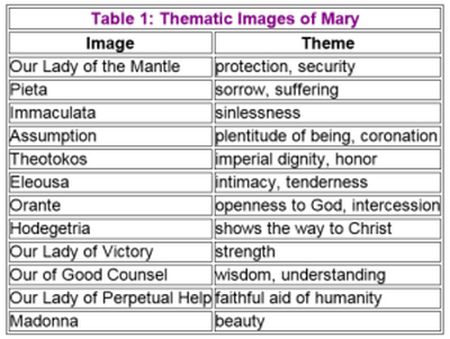
The second group consisted of 12 reproductions depicting events from the life of Mary, e.g., the Annunciation, the Birth of Jesus, the Assumption. (See Table 2.)
Table 2: Events From the Life of Mary
- Birth of Mary
- Annunciation
- Visit to Elizabeth
- Birth of Jesus Christ
- Presentation of Christ in the Temple
- Adoration of Christ by the Magi
- Flight into Egypt
- Finding of Jesus in the Temple
- Descent of the Holy Spirit
- Death of Mary
- Assumption
- Coronation of Mary
The third group consisted of marian works representing seven artistic periods, e.g., Gothic, Renaissance, 20th Century. (See Table 3.)
Table 3: Artistic Styles Used to Depict Mary
- Icon
- Romanesque
- Gothic
- Renaissance
- Baroque
- 19th Century
- 20th Century
Procedure
The participants were informed of the purpose of the survey–to measure their "thoughts, beliefs, feelings and experiences" concerning artistic depictions of the Virgin Mary. For the thematic images (Table 1), the participants selected and ranked five of them that they identified with, numbering them in order of preference, "1" indicating the image most identified with, followed by "2" and so on. There was also space for the participants to explain their selections and rankings. For the depicted events (Table 2), the participants selected and ranked three of them. For the representations from the different artistic periods (Table 3), the participants rated each on a 5-point categorical scale ranging from strongly like to strongly dislike."
RESULTS
The principal analytic strategy consisted of a series of analyses of variance comparing participants' responses to the stimuli. Responses were scored as follows: For the thematic images and the depicted events, the most preferred image was assigned a "1," the second a "2," and so on. Each of the nonpreferred images was assigned the average of the remaining ranks. For the various artistic styles, the responses "strongly like, like, don't know, dislike, and strongly dislike," were coded as "1" through "5," respectively.
Marian Themes
Preferences for the thematic images are summarized in Table 4.
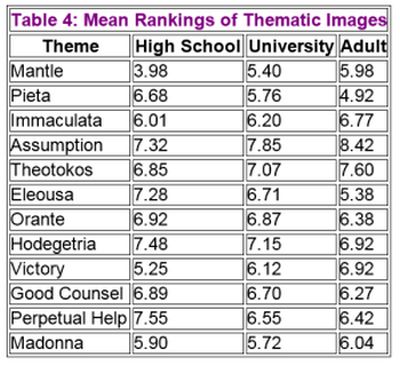
For the high school students, "Our Lady of the Mantle" was generally preferred over all other themes, whereas the second-most-preferred theme, "Our Lady of Victory," was ranked significantly higher than approximately 70% of the others. The third-most-preferred theme, "Madonna," was ranked significantly higher than approximately 35% of the other themes. For the university students, "Our Lady of the Mantle," "Pieta," and "Madonna" were most preferred, and the "Assumption," least preferred. For the adults, "Pieta," and "Madonna" were most preferred, and the "Assumption," least preferred. For the adults, "Pieta" and "Eleousa" were most preferred, and the "Assumption," least preferred.
These results were further clarified as follows: The images were grouped into two mutually exclusive types–(1) affective (mantle, pieta, eleousa, counsel, help); and (2) admiration (immaculata, assumption, theotokos, victory, madonna)–and preferences for each image type was compared across four groups of participants. 1st - 2nd year high school, 3rd - 4th year high school, college students, and adults. The means are summarized in the Figure.
1st - 2nd year high school students showed a clear preference for "admiration: images of Mary. 2nd - 3rd year high school and college students showed about equal preference for both types. Adults showed a clear preference for "affective" images.
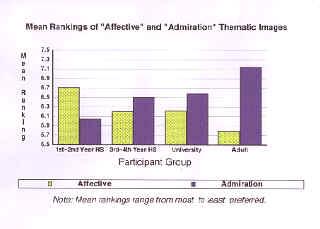
Marian Events
Preferences for the depicted events are summarized in Table 5.
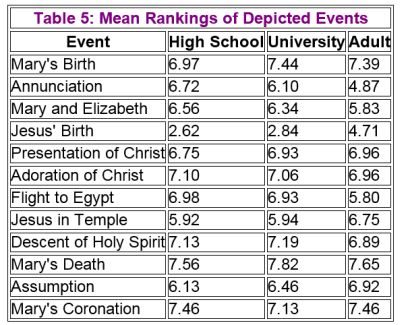
For each group of participants the most preferred image was the "Birth of Jesus." For the high school and university students, it was preferred over all other images; for the adults, it was preferred over approximately 45% of the remaining images. The second-most-preferred image for the high school and university students was "The Finding of Jesus in the Temple." For the adults, it was the "Annunciation."
Marian Styles
Preferences for the various artistic styles are summarized in Table 6.
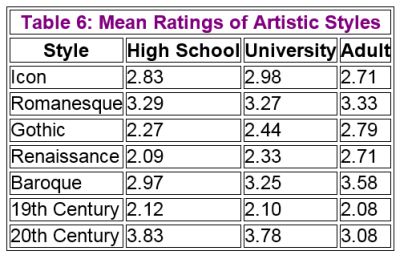
The high school students tended to prefer the Renaissance, 19th century, and Gothic styles over each of the others. The 20th century image was by far the least–preferred. High school females tended to prefer the Renaissance and 19th century styles more so than did the males. There were no significant differences in preference for the other styles.
The pattern of results for the university students was similar to that of the high school students. Those styles preferred the most–Renaissance and 19th century–were rated higher than the Icon, Romanesque, Baroque, and 20th century styles. Some preference was also shown for the Gothic style, which was rated higher than the Romanesque and 20th century. University men tended to prefer the 20th century, Icon, and Romanesque styles more so than did the women. The overall pattern of results for the adults was similar to that of the high schools and university students.
CONCLUSIONS
1. There appears to be a clear development trend in preferences for thematic images of Mary. Preferences for "affective" images strengthen with age, whereas preferences for "admiration: images weaken. The reason for this difference is not obvious. One suggestion is that younger people see Mary more as an ideal role model–one who can serve as a guide to "proper" development. They cannot yet identify with the powerful emotional themes of the pieta or eleousa, which are more accessible or personally compelling to adults. Other surveys question these results. [See Mary Page Mary and Youth Survey]
2. Why is the "Birth of Jesus" the event that people identify with the most? Perhaps the nativity scenes are the most familiar to those surveyed because of the Christmas customs of families and parochial high schools, media and shopping centers. The story of the Incarnation and Mary's role in it is possibly the most known of the marian aspects. It could also be that birth is more worldly and apprehensible.
3. We are most accustomed to viewing 19th century, Renaissance, and, to some degree, Gothic depictions of Mary, so it is not surprising that these artistic styles were the most preferred. Men were more accepting of the remaining styles–particularly the 20th century depiction–than were women. The reason for this is not at all clear. It could simply reflect differences in men's and women's predispositions to artistic styles (which should also be obtained with an entirely different group of images). Another possibility is that the 19th century, Renaissance, and the Gothic styles evoke a more "feminine" sensibility than do the other styles. Still other considerations include that fact that these styles are more often reproduced than others, and are thus more present, for instance, on stamps selected during the Christmas season and on church architecture. They also represent common devotional images, and finally, there is proximity between late Gothic and Renaissance styles. Unfortunately, the survey does not provide us with an explanation.
All About Mary includes a variety of content, much of which reflects the expertise, interpretations and opinions of the individual authors and not necessarily of the Marian Library or the University of Dayton. Please share feedback or suggestions with marianlibrary@udayton.edu.
